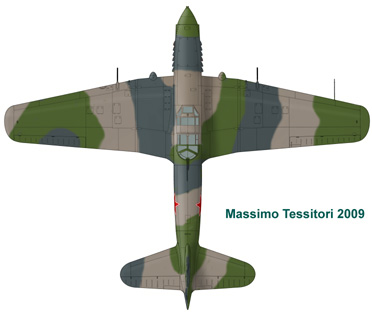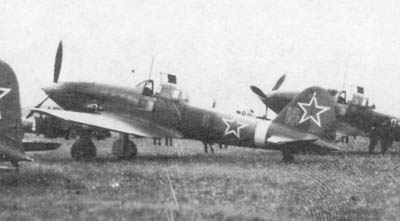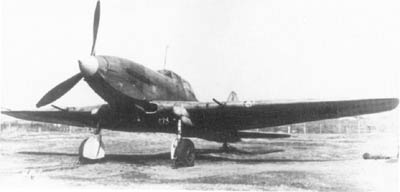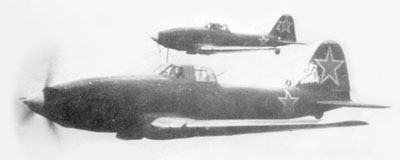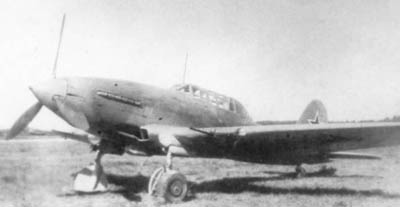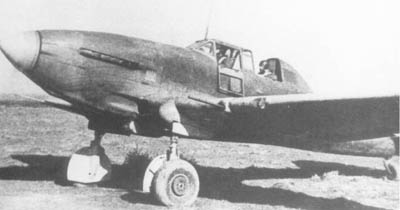Il-10 camouflage during the Great Patrioctic
War
by Massimo Tessitori
|
Updated on November 3, 2008
| When one looks for photos and profiles of Il-10, usually he finds images
of planes with solid dark green upper and side surfaces, and maybe markings
of some countries that were post-war allied of the Soviet Union.
In recent time, thanks to the monographs of Rastrenin, Gordon and Komissarov,
some wartime photos showing camouflaged Il-10s captured my attention. The
camouflage often had a very low contrast and was of difficult interpretation.
Right: Il-10s of 232 ShAP.
Image via Oleg Korytov. |
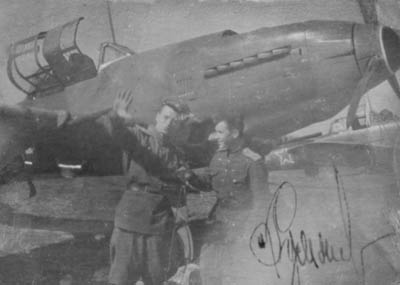 |
In a first time, the book "Colors of the falcons" of Jiri Hornat has
given the keys to interpretate the photos as variants of the 3-shades NKAP
templates of 1943 for Il-2s; but photos were still unclear, and in
some cases could have been interpretated as 2-colors camo, red brown and
green, as did the illustrator of Aviacollectia 5/2004.
Then, the translation of the researches of Vakhlamov and Orlov at
Arcforum made clear to me that, in contrast to what was previously
believed, the red brown and green camo never was a standard for Soviet-built
bombers, and encouraged me to remake this page in the present form.
Below: schemes from Colors of the falcons
 |
This template of 1943 shows Il-2s in a three-shades camouflage:
-
Light greyish-brown AMT-1 (or equivalent oil paint A-21 for all metal planes)
-
Green AMT-4 (or equivalent oil paint A-24m for all metal planes)
-
Dark grey AMT-12 (or equivalent oil paint A-32m)
with undersurfaces
-
Blue AMT-7 (or equivalent oil paint A-28m for all metal planes)
Some photos of Il-10s looks to fit a variation on this scheme. |
 |
As before, but with different camo scheme.
Other photos of Il-10s seem to show a variation of this scheme. |
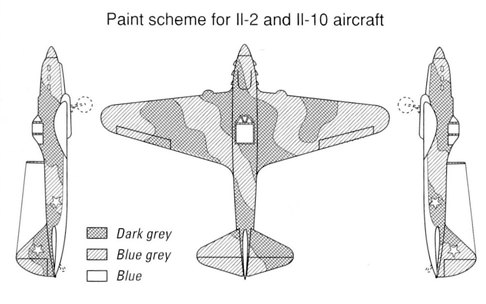 |
This template of 1945, for Il-2s and Il-10s, shows a two shades camo
made with:
-
Dark grey AMT-12 (or equivalent oil paint A-32m)
-
Blue- grey AMT-11 (oil equivalent didn't exist; it was painted on the base
of the dark grey paint)
with undersurfaces
-
Blue AMT-7 (or equivalent oil paint A-28m for all metal planes)
No any image of Il-10 known to me looks to fit with this template, so I
suppose that it was never utilized. |
I've made an effort to obtain painting schemes by comparing the available
photos to NKAP schemes of 1943; it was not easy, for the low contrast of
the camo, the bad quality of the most of the images and the strong variability
of the scheme.
Here are some photos that seem to show that these planes conformed
to a variant of the templates of 1943. Further photos are asides
the following profiles.
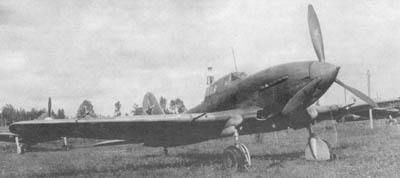
Image from Ilyushin Il-2 and Il-10 Shturmovik
This photo shows the colors of the right wing leading edge.
The succession of colors, from the root to the tip, is: dark-medium-light-medium-light,
broadly compatible with the 2nd template of 1943, after compressing
the bands to the wingroot and adding a light band to the tip. |
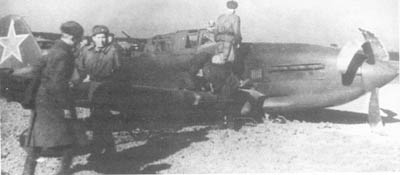
Image from Colors of the falcons
This photo shows something of the rarely seen right side: the light
brown band stops just under the canopy.
On Colors of the falcons this is described as a two-greys plane,
but the scheme doesn't fit with the 1945 template at all, so I think that
it was a three-colors camouflage according to the 2nd variant. |
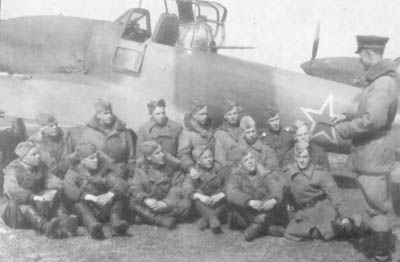
Image from Ilyushin Il-2 and Il-10 Shturmovik
This photo, on which the light brown has an unusually good contrast,
fits well with the 2nd variant of 1943, with a dark grey band added behind
the canopy.
The photo shows that the light brown band extends to the canopy. |
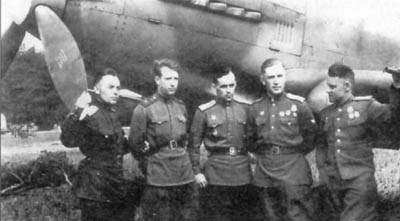
Photo from Aviakollectia 5/2004.
This photo fit fully with rge first variant, because the position
of the green and of the light brown bands appear inverted, and removes
any doubt that the planes were painted with a 3-shade camouflage. |
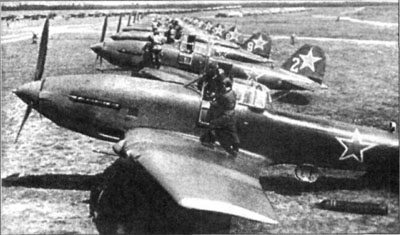
This image shows variations of the image of the 1st variant; the closer
plane looks the only one seen without a dark grey band in mid of his nose
(or perhaps it's moved to the front, faded and looks as a medium-shade
band).
The upper left wing shows a dark grey band more in addition to the
template. |

Another image that, although of bad quality about the fuselage, shows
clearly rhe upper left wing; compared to the previous photo, the dark grey
band on the wing arrives till at mid heigth of the fuselage side.
This should be a common variation of the 1st NKAP scheme.
Note that there are not photos available of the right side of this
first scheme. |
At the end, Il-10s looks to fit those general schemes, obtained by adapting
the NKAP schemes to the available photos:
Here is a profile of the first plane of the line shown on the photo.
 |
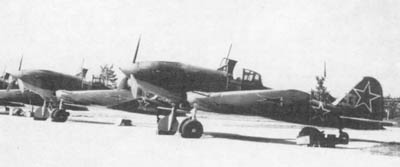
Photo from Aviakollectia 5/2004. |
This line of Il-10s can give the base for many profiles.

Photo from Aviakollectia 5/2004.
Here are those of the closer planes. The interpretation of the
colors of the codes conforms to Aviakollectia 5/2004 profiles.

The first of the following line of planes looks to wear a variant of
the first NKAP scheme of 1943.
This scheme is recognizable by the light brown band at mid of the nose
instead of a dark grey band.
For what is visible, a dark grey band is added behind the canopy and
on the left wing.
Note the white wingtips, perhaps identifying the leader's plane. Unfortunately
the number on the tail is not visible; being the line of more of 10 planes,
some tail numbers could be omitted or repeated. |

From Krilya Rodini |

This profile depicts the second plane of the line.
The scheme for light brown and green could be the same, but with a
modified disposition of dark grey bands. Note that the left upper wing
looks painted as on the closer plane. |
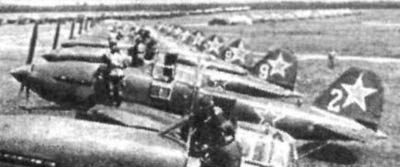 |

|

Photo from Aviakollectia 5/2005.
The photo above represents an Il-10 off 108th GShAP in Germany, 1945.
At a first look, the camouflage appears enigmatic, but I think that it's
a standard camouflage rather deteriorated on the fuselage, and fresh on
the wing. |
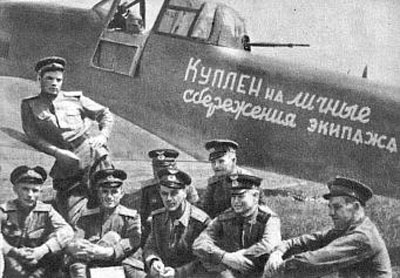

|
These photos show a camouflaged Il-10 with a slogan saying.PURCHASED
BY THE CREW'S PERSONAL SAVINGS
The pilot was from 175 ShAP, based in Latvia at the end of the
war.
Previously the same pilot bought an Il-2 (s/n 309026) for his
own savings (this is what the inscription says) and flew that Il-2 throughout
1944.
Il-10s appeared later, so probably these are postwar shots with the
inscription taken over from the old Il-2 onto the new Il-10, for propaganda
purposes or just for tradition keeping. So there is a slight possibility
that the number could be 26.
(thanks to AR) |
These photos show two different two-seater Il-10U that appear to be
painted according to the already seen schemes.
Both images from Ilyushin Il-2 and Il-10 Shturmovik
Bibliography:
-
Aviakollectia 5/2004 and 1/2005: a monograph of Rastenin on Il-10
-
Aviakollektia 12/2008: a monograph on painting of Soviet planes by Orlov
and Vaklamov
-
Colors of the falcons by Jiri Hornat
-
Ilyushin Il-2 and Il-10 Shturmovik by Yefim Gordon and Sergey Komissarov
-
Krilya Rodini
-
Discussion on
Arcforum on the painting of Soviet planes
List of updates
-
Some photos, schemes, profiles and modifications of text were made on November
2, 2009
-
Fully remade with new photos and color profiles on October 25, 2009
-
updated on November 25, 2008 with the image from Krilya Rodini
-
uploaded on December 27, 2006












